|
You're receiving this newsletter because you SIGNED UP AT FAWN.IFAS.UFL.EDU / CONTACTED FAWN IN THE PAST. Having trouble reading this email? View it in your browser. Not interested anymore? Unsubscribe Instantly. |
|
|
In this issueUnsubscribe
Contact Us
Sponsor Spotlight
|
1 million page views!
As you can imagine, the FAWN website has been busy this winter. Since January 1, 2010, we have had over 126,000 visitors to our website. Those visitors viewed over 1 million pages, and spent more than 35 minutes online per visit. This is a substantial increase over and above our normal use, and for comparison, for all 2009 50,000 unique visitors viewed 580,000 pages and spent just over 4 minutes online per visit. So in only 2 months, we have had almost half the number of visitors we had for all last year spend more than 7 times the amount of time online, viewing more than 5 times the number of pages. Thanks to all who depend on us for reliable weather data and decision-making tools! Back to top^January Climate Summary(courtesy of AgroClimate.org)Average temperatures well below normal for January. Monthly average temperatures in January were well below normal across the entire state (table below). Primary reporting stations observed average temperatures for the month at least four degrees below normal. The period January 2 – 14 was particularly cold, with numerous record low temperatures being observed. Coldest minimum temperatures were 14o F at Tallahassee and 17o F at Gainesville, both on the 11th. Tallahassee (14) and Gainesville (13) broke records for the most consecutive days with a freezing minimum temperature. A low temperature of 42o F recorded at Key West on the 11th was the second coldest temperature on record. The strength of the cold was evident as numerous record low maxima were recorded across the central and southern portions of the state. In contrast, later in the month daily record maxima were set at Melbourne (82o F on the 17th), Miami (86o F on the 22nd), and Tallahassee (76o F on the 23rd).
Read the full report at AgroClimate.org Back to top^Tool/product updatesNew Homepage Map. Urban Irrigation Scheduler. Our Urban Irrigation Scheduler continues to evolve based on the results of ongoing research in this field. Current recommendations suggest a seasonal adjustment to a percentage of the number of minutes the controller is set to run. Then, we recommend that you turn your system on or off based on the weekly rainfall and ET. Check these updates out at http://fawn.ifas.ufl.edu/tools/urban_irrigation/. FAWN thanks the Southwest Florida Water Management District for funding this enhancement to our website. Pesticide Application Tool. FAWN Mobile. Additional Sources of Data. Field updates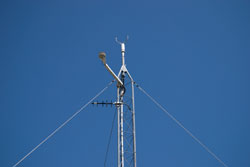
The FAWN Field Site Team has been busy this quarter. They conducted routine maintenance at Arcadia, Apopka, Avalon, Citra, Bronson, Dover, Frostproof, Immokalee, Lake Alfred, Ocklawaha, Putnam Hall, and Sebring. They also conducted field tests, or “Benchmarked” (compared the sensors to ones of known calibration to ensure accuracy) at Apopka, Avalon, Frostproof, Lake Alfred, and Sebring. The work our field team does maintaining and testing the sites ensures that we provide reliable data to our users. You can view the most recent maintenance records from each FAWN site page at the lower right corner of the tower graphic. We are also in the process of relocating two sites; the Ft. Pierce tower to a different part of the Indian River Research and Education Center so future construction can occur, and the Umatilla tower to a piece of city property adjacent to the Umatilla airport. There will be no interruption in data during these relocations. Back to top^Outreach
In January, FAWN conducted its first annual Winter Weather School. This event was held in Bartow at the Polk County Extension Office. Presentations were given by UF and FAWN personnel on using water for cold protection, citrus irrigation, and technology for evaluating freeze protection needs. Many thanks to the Southwest Florida Water Management District for funding this event. We also exhibited at Agritunity 2010 in Bushnell and the Tampa Spring Expo in Tampa. We have given several presentations at grower and homeowner meetings as well, speaking at the Tree an Landscape Short Course in Plant City, the Farm Help seminar in Belle Glade, and the Winter Weather Seminar in Immokalee. Also, FAWN is now a regular part of the Sumter County Cooperative Extension Office’s monthly New Resident Meeting in the Villages, where we teach new residents how they can save water and dollars by using our irrigation resources. We recently began deploying our new portable tower at trade shows and conferences to provide on-site weather conditions. It is a surplus military communications tower that we renovated and outfitted with sensors and communications equipment. It is essentially a FAWN tower on wheels. It will appear next inside the Leon County Civic Center on March 16th at the Florida Farm Bureau legislative reception. Back to top^Ten Years of FAWNFAWN is a program of the University of Florida IFAS Information Technology department, and was established in 1997 to provide timely and reliable weather data to Florida citizens. FAWN thanks the South Florida Water Management District, the Southwest Florida Water Management District, the St. John’s River Water Management District, the Florida Department of Agriculture and Consumer Services, and its Sponsors for their financial support. Back to top^ |
||||
|
|||||

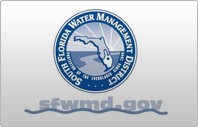
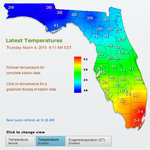 We recently updated our Homepage to show colorized views of several parameters. You can now view current temperature and ET in color by clicking one of the buttons under the map. This presents an easy way to view these parameters over a larger area. FAWN thanks the Southwest Florida Water Management District for funding this enhancement to our website.
We recently updated our Homepage to show colorized views of several parameters. You can now view current temperature and ET in color by clicking one of the buttons under the map. This presents an easy way to view these parameters over a larger area. FAWN thanks the Southwest Florida Water Management District for funding this enhancement to our website.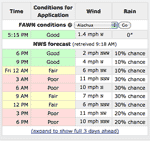 Under development is a pesticide application tool for low volume applicators, and will be a significant addition to our tool box. Conditions for spraying will be categorized using the National Weather Service (NWS) forecasted wind speeds. At right is a screenshot of what the tool will look like. The current conditions at a FAWN site are displayed, along with 3-hourly forecasts of wind speed and rain. Users will be able to view the conditions for application along with current data from a FAWN site, then print all this for use in the field and/or record keeping. Please stay tuned for further developments on this tool.
Under development is a pesticide application tool for low volume applicators, and will be a significant addition to our tool box. Conditions for spraying will be categorized using the National Weather Service (NWS) forecasted wind speeds. At right is a screenshot of what the tool will look like. The current conditions at a FAWN site are displayed, along with 3-hourly forecasts of wind speed and rain. Users will be able to view the conditions for application along with current data from a FAWN site, then print all this for use in the field and/or record keeping. Please stay tuned for further developments on this tool.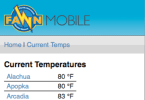 We recently updated the look of the mobile version of our website for a sharper, easier to read display of data and information. Currently, users can access the latest FAWN news, as well as current observations from a FAWN site. Point your mobile device to fawn.ifas.ufl.edu/mobile and stayed tuned for further enhancements and the addition of FAWN tools for access in the field.
We recently updated the look of the mobile version of our website for a sharper, easier to read display of data and information. Currently, users can access the latest FAWN news, as well as current observations from a FAWN site. Point your mobile device to fawn.ifas.ufl.edu/mobile and stayed tuned for further enhancements and the addition of FAWN tools for access in the field. On each station page, we recently added data from nearby sites from which the NWS collects data. We display the most recent temperature and rainfall amount from the closest 2 sites, and a link to a map that shows the relative positions of the FAWN and NWS sites. FAWN thanks the Southwest Florida Water Management District for funding this enhancement to our website
On each station page, we recently added data from nearby sites from which the NWS collects data. We display the most recent temperature and rainfall amount from the closest 2 sites, and a link to a map that shows the relative positions of the FAWN and NWS sites. FAWN thanks the Southwest Florida Water Management District for funding this enhancement to our website